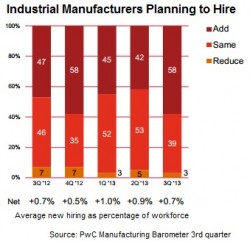 Hiring plans by American manufacturers are at the highest level in five years, and the 58 percent of industrial employes who say they expect to add workers in the next 12 months is the second-highest percentage of the last 10 years.
Hiring plans by American manufacturers are at the highest level in five years, and the 58 percent of industrial employes who say they expect to add workers in the next 12 months is the second-highest percentage of the last 10 years.
The jobs expansion is matched by their optimism in the U.S. economy and their rising confidence that the global economy is also improving.
A quarterly “Manufacturing Barometer” from PwC says that 60 percent of the industrial manufacturers the accounting and business consulting firm surveyed were optimistic about the U.S. economic future. Last year, PwC’s third-quarter survey found only 37 percent expressing optimism. Those doing business globally were less confident about the world economy, with 40 percent confident about the economic direction. Still, that’s a rise of 23 percentage points from last year.
That optimism, coupled with the 82 percent expecting positive revenue growth of 4.2 percent is fueling plans for hiring and new investments. On average the 60 very large manufacturers (average workforce size = 78,586) expect to add an average of 550 workers each, or .7 percent of their workforce.
They’ll be looking to bring on skilled labor (35 percent), professionals and technicians (also 35 percent), and production workers (30 percent) among others. Finding the right skilled workers, however, is enough of a challenge that just over one-in-five manufacturers identified the lack of qualified workers as a possible barrier to growth.
 PwC included a special section on manufacturers’ human capital challenges in its Barometer report. Seventy-seven of the respondents said they have a need to fill skills gaps, identifying middle management (70 percent) and skill labor (67 percent) as their biggest gaps. They’ll be looking to add workers with engineering (48 percent) and manufacturing (45 percent) skills. To do that, a majority of the companies plan a major hiring initiative, while 85 percent plan some hiring effort. Training existing staff, hiring outside contractors, and redeploying internal talent also figure into their skills gap strategies.
PwC included a special section on manufacturers’ human capital challenges in its Barometer report. Seventy-seven of the respondents said they have a need to fill skills gaps, identifying middle management (70 percent) and skill labor (67 percent) as their biggest gaps. They’ll be looking to add workers with engineering (48 percent) and manufacturing (45 percent) skills. To do that, a majority of the companies plan a major hiring initiative, while 85 percent plan some hiring effort. Training existing staff, hiring outside contractors, and redeploying internal talent also figure into their skills gap strategies.
For nearly 9 out of 10 of the manufacturers, talent management (“the development of talented/skilled workers,” according to the report) as a top 10 priority. Nearly half (47 percent) consider it a top five priority.